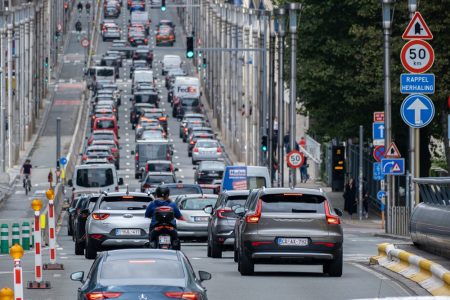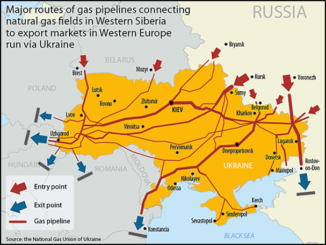
As EU transport ministers gather for an informal meeting in Brussels on Wednesday (3 April), the sector remains the “problem child” of the bloc’s climate efforts and could account for 44% of all greenhouse gas emissions by 2030, according to latest projections.
While climate-wrecking emissions from economic sectors such as energy, industry, buildings, and agriculture have fallen since 1990, greenhouse gas emissions from transport have risen by 26%, reaching 1,046 megatonnes of CO2 in 2023.
While they could fall slightly by 2030, according to a report by the NGO Transport & Environment (T&E), this would still leave transport emissions well above the EU’s overall emissions reduction target of -55%, compared to 1990 levels, and would leave other sectors to do the heavy lifting.
If other sectors reduce emissions in line with the EU’s target, the transport sector could soon account for 44% of total emissions, up from 29% today, the report says.
Transport is “the problem child of Europe’s climate efforts”, said William Todts, T&E’s executive director. On Wednesday, he will present some of the report’s key findings to transport ministers from the EU’s 27 countries, who are gathering for an informal meeting in Brussels to discuss the “greening of transport”.
A key reason for the rise in transport emissions is the increase in people’s mobility, with car kilometres up 15% since 2000 and emissions from aviation more than doubling since 1990.
Emissions from freight transport have also increased, with emissions from lorries and buses up 25% and those from shipping up 20% compared to 1990.
While technological solutions such as electric cars are available, they will take time to deploy, with only one in six new cars sold in 2023 being fully electric. With the average life of a car between 18 and 28 years, it will take time for electric cars to replace Europe’s current fleet.
As a key measure to boost demand for electric cars, T&E wants the EU to regulate company cars, which account for 58% of all new car sales, an idea that the European Commission is currently testing via a public consultation.
Pressure on national governments
The pressure to reduce transport emissions is mainly on national ministers because road – the largest contributor to transport emissions – is included in national climate targets under the EU’s Effort Sharing Regulation (ESR).
A European Commission report last December showed that 19 of the 27 EU countries are currently off track on their ESR targets, largely due to a lack of action in the transport sector.
While all member states are promoting electric mobility, they are shying away from measures that could be seen as restricting people’s mobility, amid fears that this could spark unrest similar to the recent farmers protests across Europe.
Ireland’s Transport Minister Eamon Ryan expects the transport sector’s climate targets to be even harder to meet than those for agriculture, while Christian Lindner, leader of Germany’s liberal FDP party and Germany’s finance minister, recently warned against “harsh interference with freedom” in people’s mobility.
Future carbon price unaccounted for
A key uncertainty over future transport emissions stems from road’s inclusion in the EU’s emissions trading scheme from 2027. This will put a price on every ton CO2 emitted by road transport. This should incentivise individuals and businesses to choose lower carbon transport options.
Only seven EU countries have taken the new scheme into account in their national projections, the Commission complained. The T&E projection has also not yet modelled the impact of the ETS2, due to uncertainty about its effect on prices.
While the EU institutions hope to limit the extra cost of the scheme to €45 per tonne of CO2 (about 10 cents per litre of petrol or diesel), this is not guaranteed, prompting some stakeholders to question the introduction of the ETS2.
To counter any potential price surge above €45, the Commission could dump additional emission allowances on the market, making use of the so-called ‘Market Stability Reserve’. However these extra allowances would undermine efforts to reach the EU’s climate targets.
Take the Survey at https://survey.energynewsbeat.com/
ENB Top News
ENB
Energy Dashboard
ENB Podcast
ENB Substack



